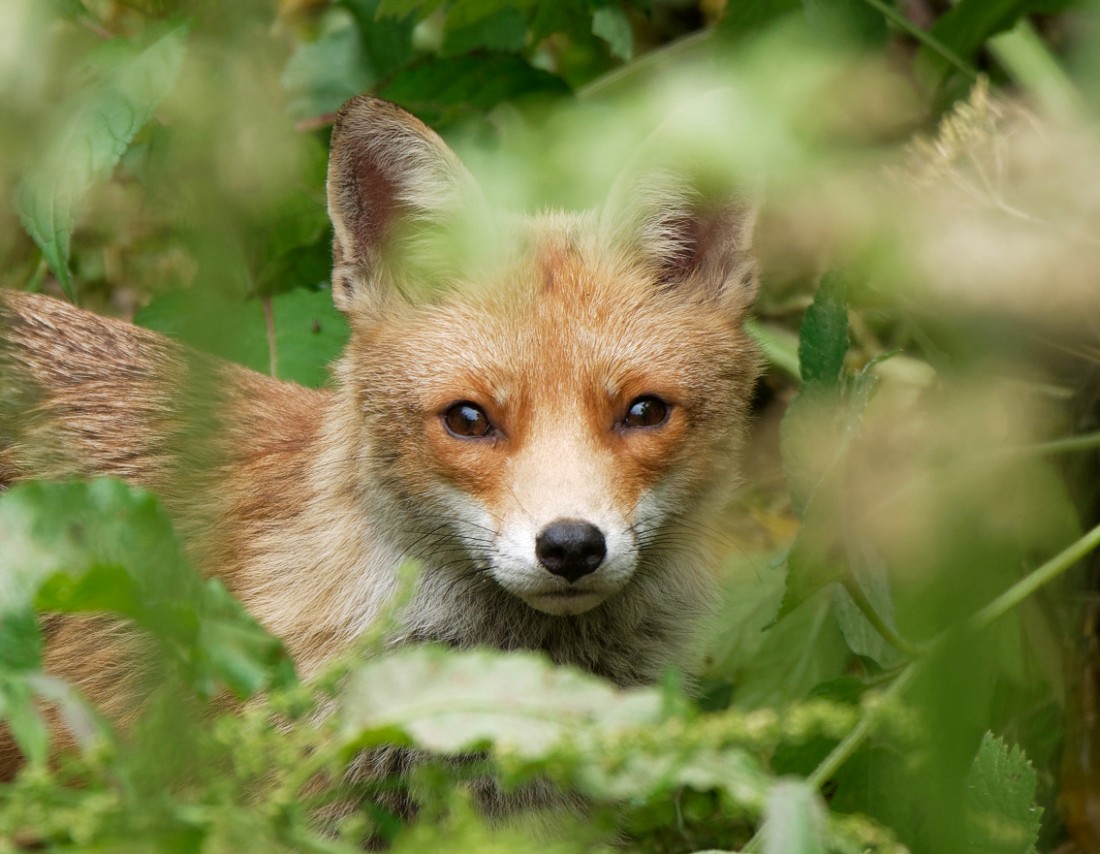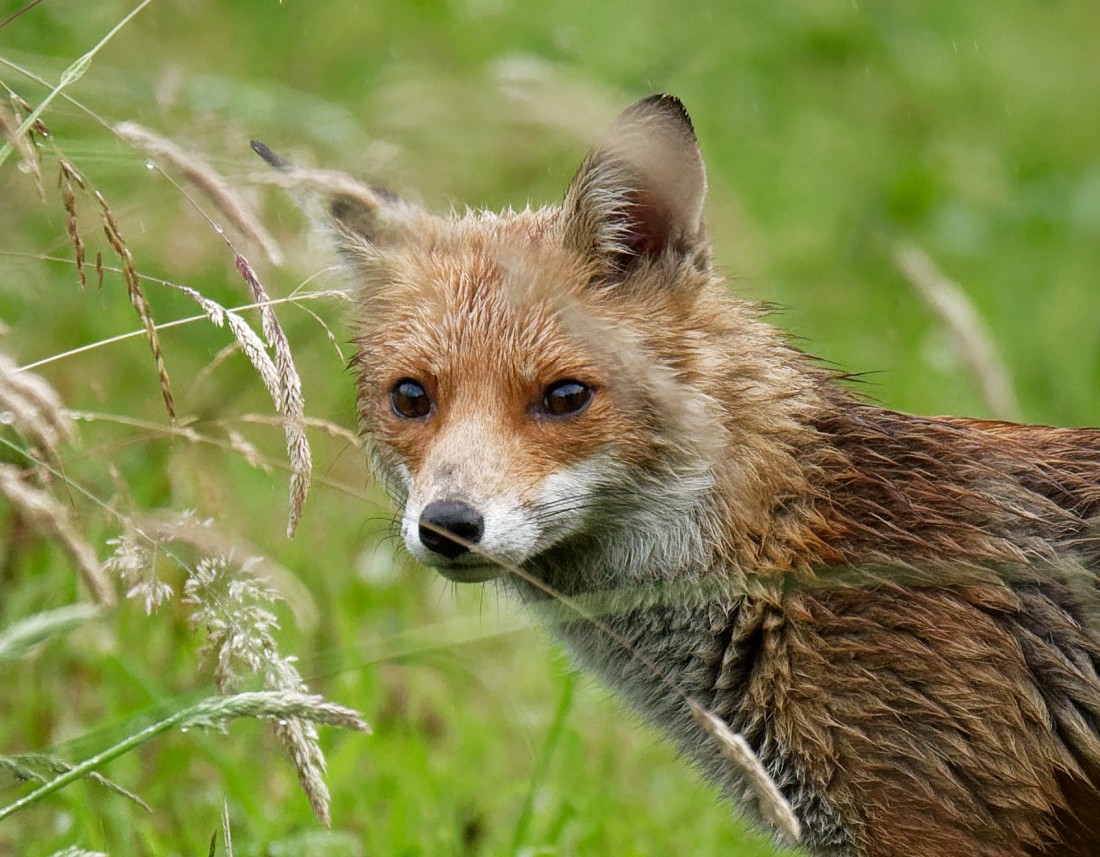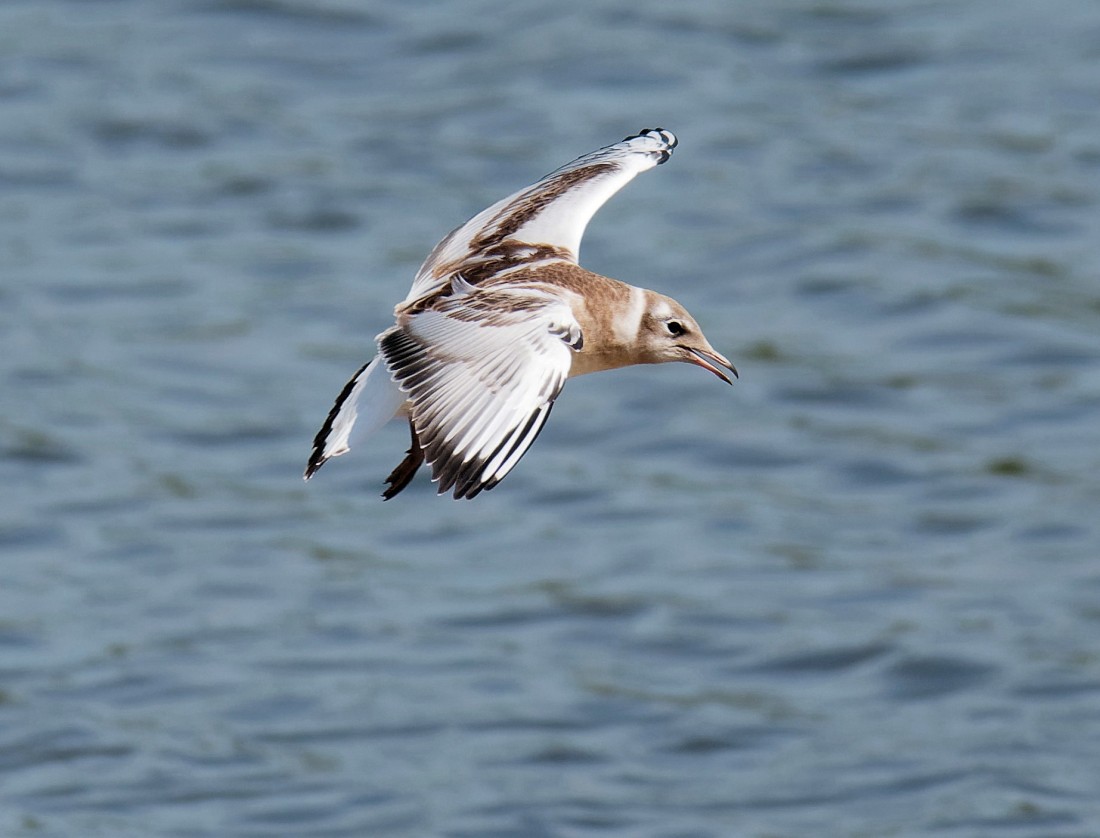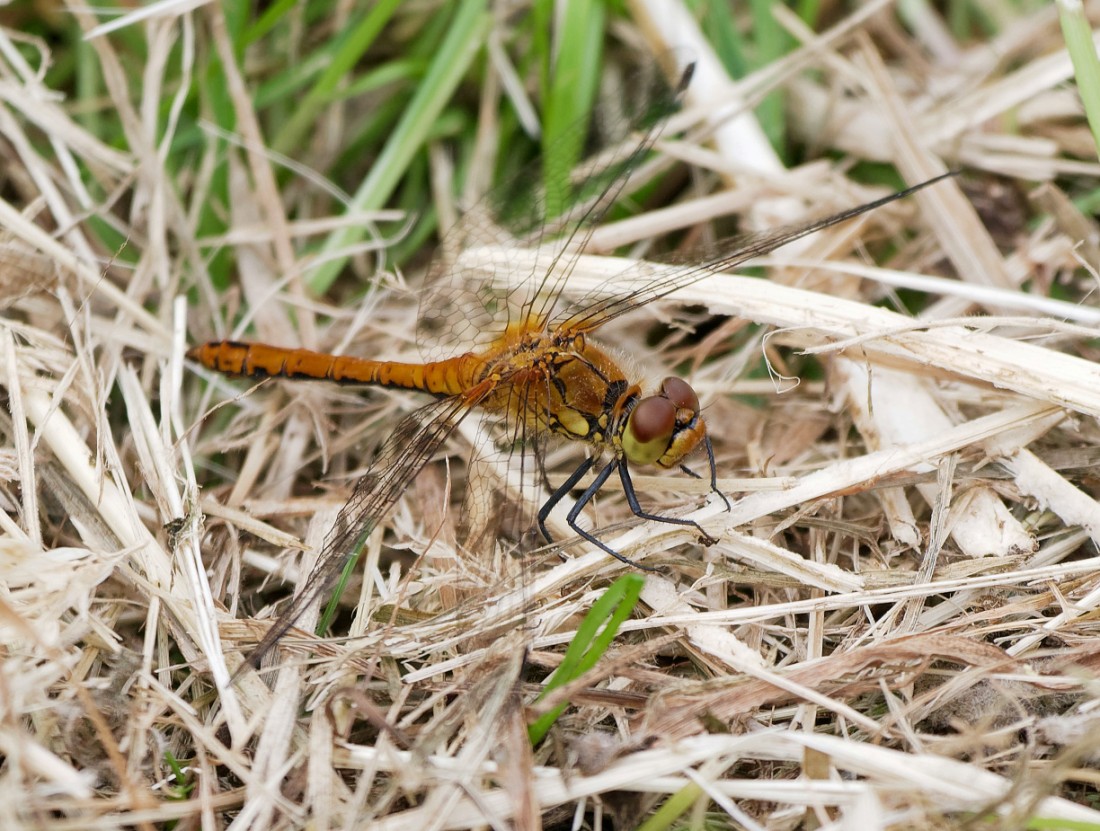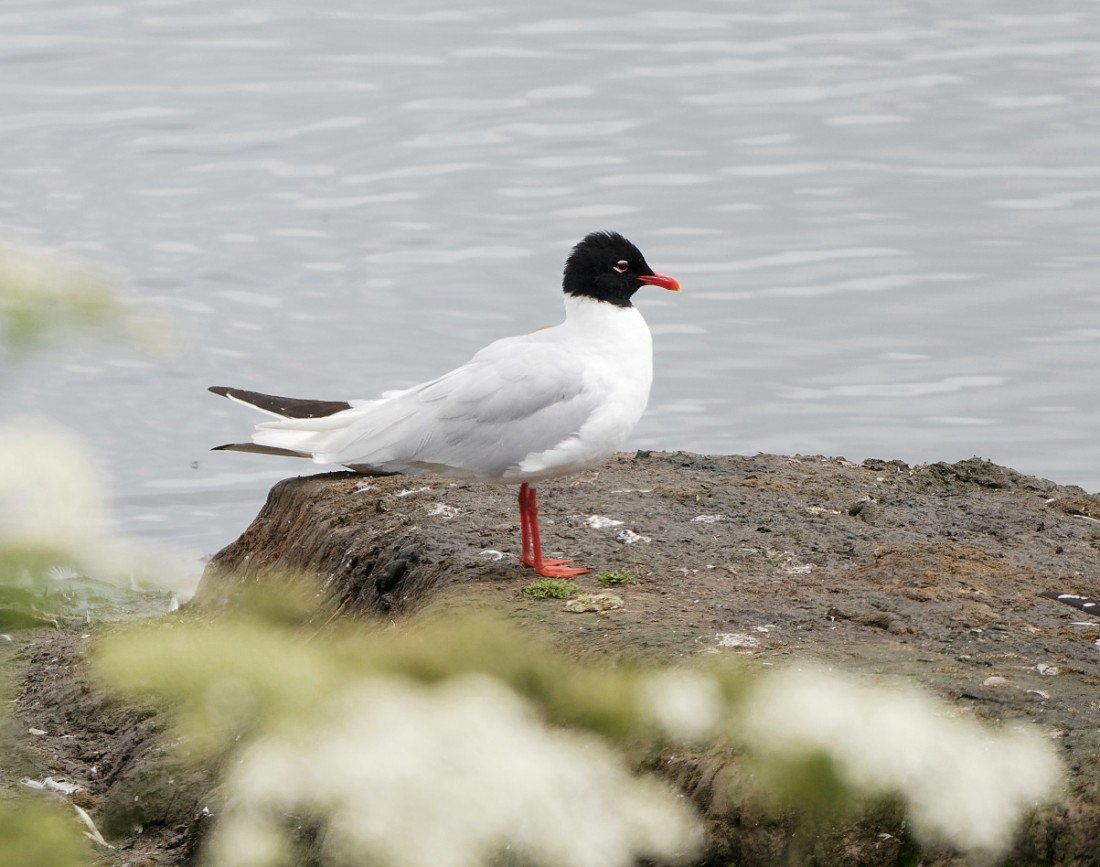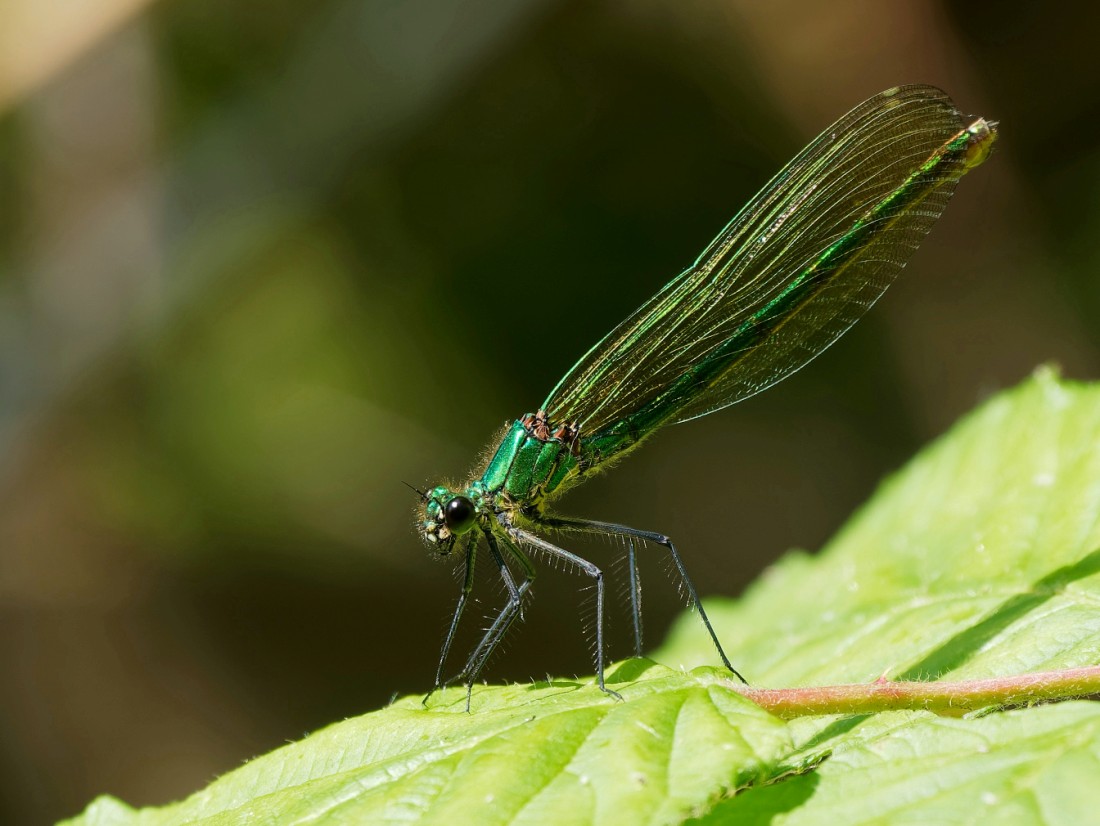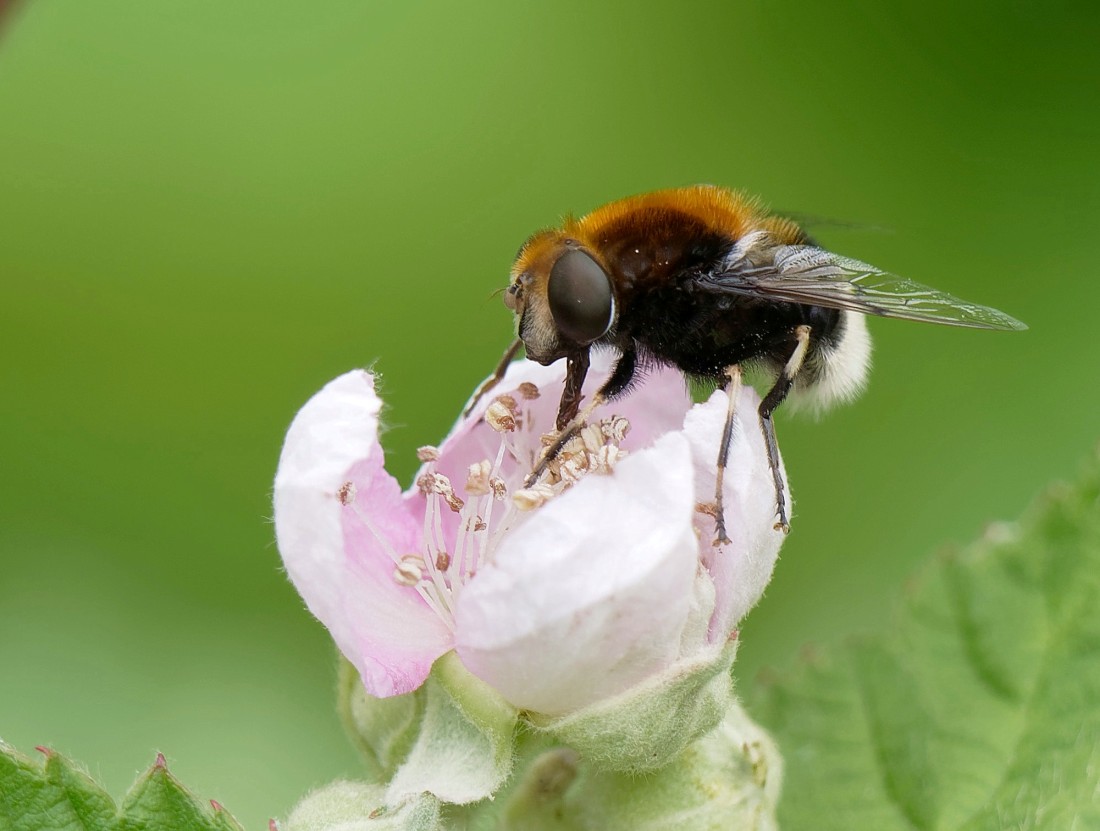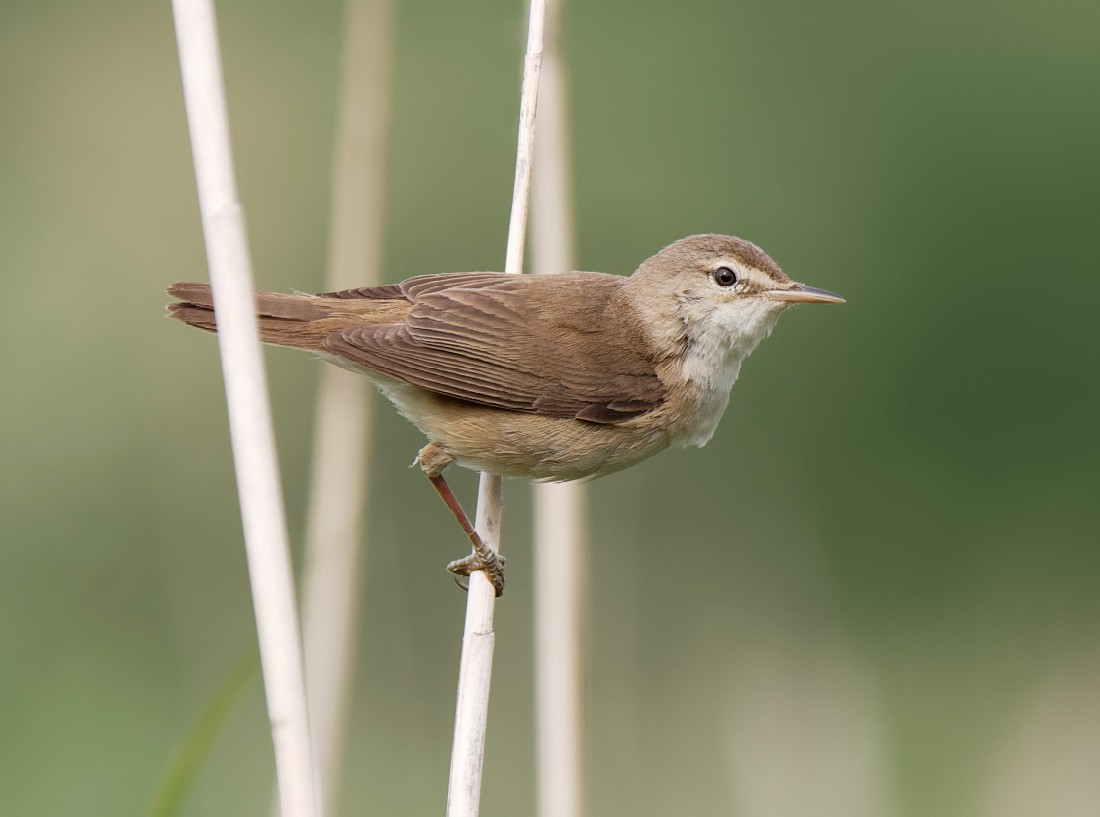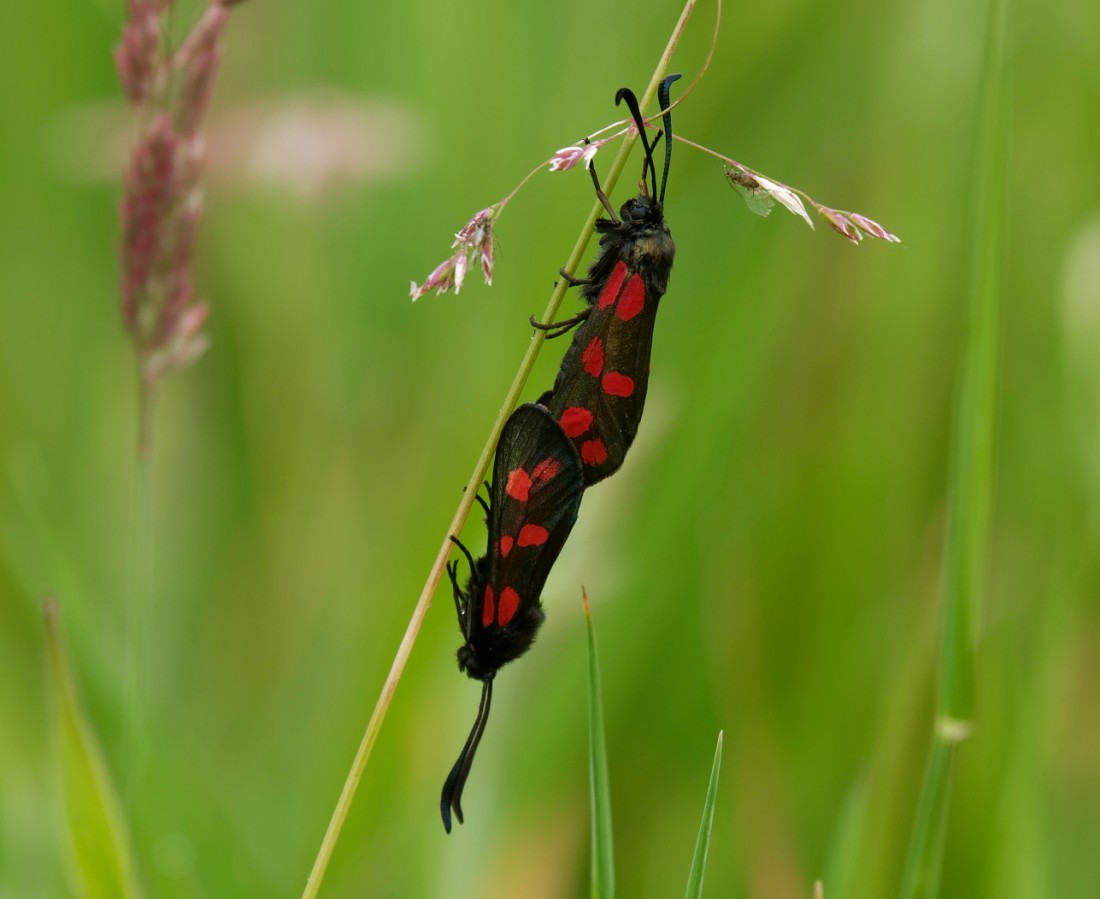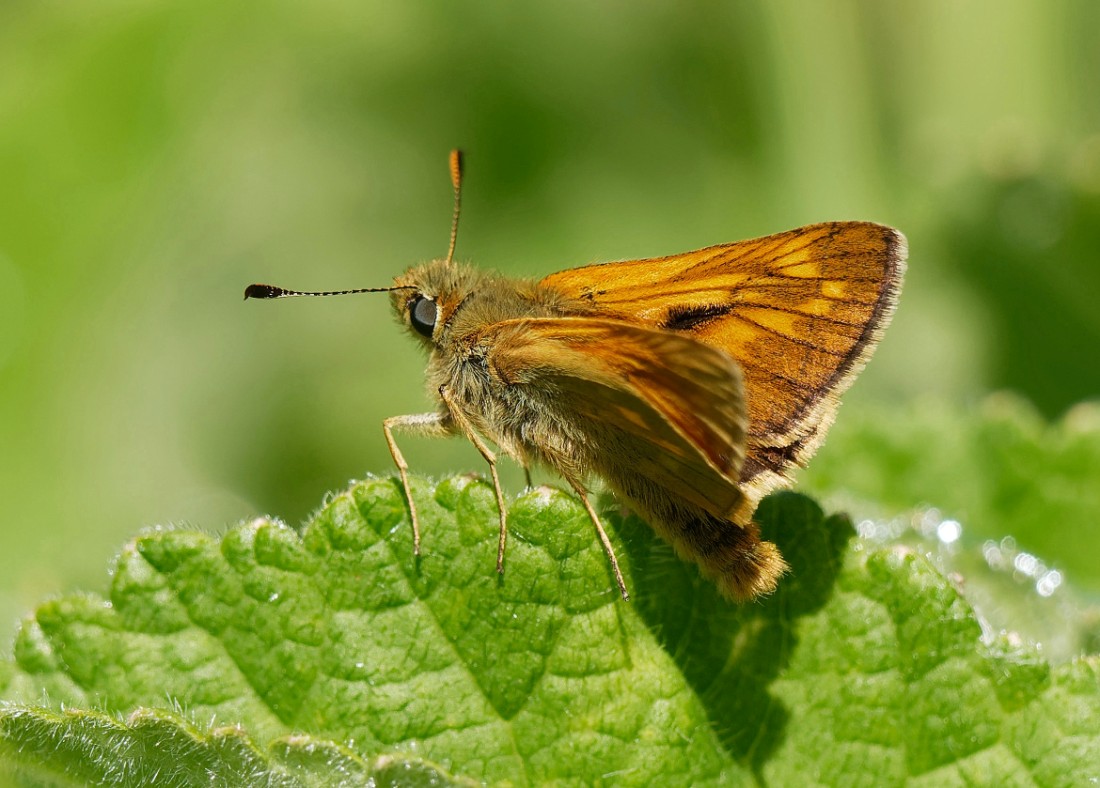Woolston Eyes Monthly Sightings
2020-06-30
Midsummer is a time of plenty in No.3 bed, with hoards of warblers feeding in the dense, flower-rich vegetation. Common Hogweed, in particular, with its nutritious seeds and insect-rich flowers is particularly magnetic to the adults with hungry young mouths to feed. I spent a relaxing hour watching and trying to photograph the visitors to one particular patch, with Whitethroats, Reed Warblers, Blackcaps, Chiffchaffs, Willow Warblers, Reed Buntings, Blue Tits, Great Tits, Dunnocks and Goldfinches all feeding, oblivious to my presence. One visitor, however, did take notice, as I spotted a Fox peering at me from the undergrowth. It seemed quite relaxed and let me take a handful of shots before ambling back into cover. Its also a time to be on the lookout for waders on return passage from their northerly breeding grounds and a lot of scanning was eventually rewarded when three Common Sandpipers dropped in to rest on one of the nest rafts, followed by three Black-tailed Godwits, fresh in from Iceland, which didn’t stop and finally, an Oystercatcher which did. Other sightings of note were: a Hobby hunting Swifts, plenty of Black-necked Grebes feeding young and a new brood of three tiny Tufted Ducks, the tenth of the year. Photo of the Fox Cheers David
Submitted by: David Bowman
2020-06-27
A day of dodging the showers (not entirely successfully!) concentrating on our breeding Black-necked Grebes and raptors. It’s been a decent season for the grebes, with 14 young and 12 adults located, while the three fully grown, independent young seem to have moved on. Walking along the No.2 bed track to check on the Kestrels, the female flew out from near the nest box, calling, while her two young, now fledged, slid out of sight behind the nest tree. Good to have them back as a breeding species after a short absence. Walking further on towards the Viaduct we were met by a free-flying young Peregrine, which skimmed over our heads before taking a perch under the shelter of the Viaduct. It seems likely that the second juvenile was also somewhere nearby, though we didn’t manage to find it. We then picked out the two adults and spent some time watching the female tearing apart the carcase of a pigeon. She must have already fed the young, otherwise they would have given her no peace! Finally, walking back onto No.3 bed we had a close encounter with a Fox. Photo of the Fox Cheers David (with Helen Wynn)
Submitted by: David Bowman
2020-06-25
A bake-hot morning started with a 7.30 am meeting with our contractor, Steve Fletcher, who is constructing the new No.4 bed wetland for us. Steve’s is making excellent progress and we managed to find a possible way around a recent technical hitch. So, we should stay on track for completion of the first wetland cell by the end of the year and of the second cell by the end of 2021. Its already looking very impressive. Hobby, Oystercatcher and a flock of 40 Lapwings were casual sightings during the meeting. Then it was on to No.3 bed to shelter from the sun and do some counts of the breeding birds. As ever, you can’t help but be struck by the sheer volume of birds in No.3 bed when breeding is in full swing. Well over 1,000 “wetland” birds were noted, made up of: 450 Black-headed Gulls (including 47 adults still on nests and 40 well-grown juveniles), 320 Gadwall, 210 Canada Geese and 80 Coot (40 juveniles) plus smaller numbers of Black-necked, Great Crested and Little Grebes (all with young), Teal, Shoveler, Mallard, Tufted Duck, Pochard, Shelduck, Moorhen, Greylag Goose and Lapwing. Gives you an idea of just what the much larger No.4 bed wetland should be like in a year or two. Photo of a juvenile Black-headed Gull Cheers David (with Dave Steel)
Submitted by: David Bowman
2020-06-23
On a humid morning I divided my time between counting Black-necked Grebes and doing some counts of dragonflies and butterflies around the bed. Without trying too hard, I was able to find 13 adult Black-necked Grebes and 12 young, three of which were fully-grown. As ever, a few Lesser Black-backed Gulls from the local breeding colony were cruising the bed in search of a snack and this time it was a young Black-headed Gull which was taken. The Lapwing pair on the Morgan Hide scrape, meanwhile, continue to put up a sterling defence of their two young, which still have some way to go before they can be considered safe. Butterfly numbers are still relatively low, though the masses of caterpillars, particularly of Peacocks, should see this change, weather permitting. Counts totalled: 1 Painted Lady, 5 Large Skippers, 3 Red Admirals, 1 Comma, 10 Small Tortoiseshells, 2 Peacocks and 3 Large Whites. Conditions were good for dragonflies and I managed to find: 2 Ruddy Darters, 3 Red-eyed Damselflies, 7 Black-tailed Skimmers, 2 Brown Hawkers and scores of Azure, Common Blue and Blue-tailed Damselflies. Photo of a Ruddy Darter Cheers David
Submitted by: David Bowman
2020-06-20
This morning we undertook a coordinated count of Black-necked Grebes around No.3 bed and managed to find a tenth brood and a total of 13 adults and 18 young, which represents a decent breeding season for this rare grebe. At this time of year we are also on the lookout for the first waders on return passage from their northern breeding grounds and were rewarded with a single Green Sandpiper, which paused to feed briefly before being driven off by the resident female Lapwing for getting too close to her young. A Little Ringed Plover then arrived and stayed, being briefly joined by a smart Mediterranean Gull. Highlight of the day, though, was sharp-eyed Helen finding two Smooth Newts among the masses of froglets and toadlets along the paths. Although we know from past surveys that the Reserve holds thousands of newts, including a large number of the rare Great Crested Newt, we rarely get to see them. Photo of a Mediterranean Gull Cheers David (with Dave Steel and Helen Wynn)
Submitted by: David Bowman
2020-06-16
It is always memorable when nature delivers something a bit out of the ordinary, as it did today. The morning started off overcast and slightly misty before clearing to become warm and humid. Early scanning for broods on No.3 bed added a sixth brood of Tufted Duck to go with the nine broods of Black-necked Grebe and twelve of Pochard already found. Two late reeling Grasshopper Warblers and two adult Mediterranean Gulls were other good additions, while two Oystercatchers dropped in to feed briefly and 100 Swifts swirled overhead. Doing some macro photography along the South Bank my eye was caught by what looked like a tiny wasp with red markings, half hidden deep in the path-side vegetation. A closer look revealed the fronded antennae of a clearwing moth, though I wasn’t sure which species. These are rarely-encountered, day-flying moths which mimic wasps to gain protection from predators. From photographs I took it was identified as the rare Red-tipped Clearwing, the first I’ve ever seen and only the fifth to be recorded in Cheshire, including two previously at Woolston Eyes (in 1993 and 2019). As beautiful as it is rare, a really special find (see photo). Cheers David
Submitted by: David Bowman
2020-06-15
This link to a brief video shows some of the breeding activity this week. It includes: singing Song Thrush and Willow Warbler, the young of Kestrel, Peregrine and Great Crested Grebe, one of the adults from our four pairs of Little Ringed Plover, Ovipositing Damselflies, copulating Black-tailed Skimmers, a female Banded Demoiselle, a female Lapwing brooding small young, one of three moulting drake Shovelers and one of the pairs of Black-necked Grebes with well-grown young.
Click here to watch David’s video……….. or simply copy and paste the following link into your browser https://youtu.be/YQsH6EZ-0no Cheers David
Submitted by: David Bowman
2020-06-13
A beautiful, if slightly humid, morning surveying Nos.3,2 and 1 beds and the area around Bollin Point. While the early focus was on the breeding birds, we ended with a dragonfly survey of No.1 bed. Birding highlights included: three pairs of Little Ringed Plovers, each with young, Kestrel and Peregrine broods doing well, Grasshopper Warbler and three Garden Warblers in song, two adult Mediterranean Gulls (reported by Kieran Foster), plus Kingfisher and Sand Martins at a regular canal-side breeding site. Plenty of butterflies were on the wing, too, with singles of Painted Lady, Comma and Red Admiral plus Speckled Woods, Large Skippers, Large Whites, Small Tortoiseshells and Peacocks. For dragonflies the seventeen new pools on No.1 bed, alongside the existing pools, are really starting to produce the goods, with counts of: 8 Black-tailed Skimmers (three ovipositing pairs and 2 males), 4 Emperor Dragonflies (3 males), 3 Banded Demoiselle (1 male), 3 Southern Hawkers, 2 male Broad-bodied Chasers, 2 Four-spotted Chasers (1male), plus around 60 “blue” damselflies, mainly Azure and Common Blue, with a few Blue-tailed. Altogether, another brilliant day. Photo of a Banded Demoiselle Cheers David (with Dave Steel and Helen Wynn)
Submitted by: David Bowman
2020-06-11
An overcast day with a cool north-easterly wind, produced a late, north-bound Greenshank and a steady easterly passage of Swifts and hirundines. By the end of the morning 210 Swifts, 30 Swallows, 35 Sand Martins and 25 House Martins had passed through. Dave Steel and I also did a systematic count of Black-necked Grebes and managed to locate 17 adults and 15 young (out of the 18 young which have been noted so far this breeding season). Hopefully the others were tucked away, sheltering from the chill wind. On the Morgan Hide scrape, the Lapwing pair have already lost one of their three young, though the female was assiduously brooding the two remaining young whenever a squall passed through. Something I regularly comment on is the insect richness of the Reserve, which is one of the reasons it supports such a density of breeding birds. As I was walking off, after a solid eight hours of scanning, the wind dropped and the masses of bramble flowers were suddenly covered in hundreds of bees, hoverflies and sunning damselflies, as well as my first Brown Hawker of the year. Cheers David
Submitted by: David Bowman
2020-06-10
Here’s a link to a video from yesterday’s brood monitoring on No.3 bed. As well as showing some of the Pochard and Tufted Duck broods, it also shows a brood of three well-grown Black-necked Grebes (the second of three, so far) which I’d previously missed - making nine broods to date (3,3,2,2,2,2,2,1 and1)
To watch David’s video click here…. or simply cut and paste the following link into your browser
https://youtu.be/ThCRiMsSrm8 Cheers David
Submitted by: David Bowman
2020-06-09
A pleasant morning, mainly spent trying to assess the breeding success of our key water-birds on No.3 bed. Black-necked Grebes are doing well, with another brood located - our eighth of the season so far. At least three other adults were skulking at the edge of the reed-bed hopefully indicating that they were guarding females on nearby nests. A twelfth brood of Pochard was another good outcome, though some of the earlier broods are proving elusive. Hopefully they’ve taken the young into cover to escape the depredations of the marauding Lesser Black-backed Gulls, rather than having lost them to predation. A fourth brood of Tufted Duck, with just one small surviving chick, probably has had the rest predated, though. On the Morgan Hide scrape, the resident Lapwing pair were zealously guarding three newly hatched young. As ever, there were plenty of other sightings of note, including: 2 passing Common Terns, 2 Kingfishers, 3 Water Rails, 4 Cetti’s Warblers and plenty of Swifts and hirundines. Cheers David
Submitted by: David Bowman
2020-06-06
Despite the blustery and wet weather this morning we managed to get some decent information on our breeding birds. After finding Kestrel young last week, it was good to see two well-grown young Peregrines at the nest site. They are past the danger point now and barring a long wet spell or loss of an adult, should fledge successfully. We then watched a Grey Heron take an almost full-grown young Coot, which it proceeded to kill by alternately giving pick-axe like blows with its beak and shaking and dunking. We moved on before it disappeared down the heron’s gullet! We then confirmed four breeding pairs of Little Ringed Plover, three of which have young already and two pairs of Grey Wagtail. On No.3 bed, 6th and 7th broods of Black-necked Grebe, an 11th brood of Pochard and the 3rd of Tufted Duck were all good finds. Another feature of the day was the 130 Swifts, 80 Sand Martins, 60 House Martins and 25 Swallows brought down by successive passing squalls.
Click here to watch David’s video………. or simply copy and paste the following link into your browser, https://youtu.be/rVqCxr3KYEg
The link is to a video showing: juvenile Swallows, Grey Wagtails, Song Thrush, Pheasant, 6-spot Burnet Moths, masses of birds in front of the Morgan Hide, Shelduck with young, Pochard with young, Coot and Moorhen young, Little Ringed Plover, a juvenile Pied Wagtail, Lapwing, Black-headed Gull young and finally, Black-necked Grebe young. Cheers David (with Dave Steel and Helen Wynn)
Submitted by: David Bowman
2020-06-04
Today saw a change in the weather, with a heavy overcast, a freshening north-westerly breeze and the odd light shower. This is the time of year for confirming breeding numbers, particularly for our scarcer species, so it was pleasing to find a fifth brood of Black-necked Grebes, a tenth brood of Pochard and a third (possibly fourth) breeding pair of Little Ringed Plovers. One of the features of the day was the number of Swifts and hirundines brought down by the conditions, to feed low over the various water bodies. The availability of so much aerial prey inevitably brought in a hunting Hobby, which chased a House Martin and looked to be about to catch it when they disappeared at high speed over the trees. Among the other sightings of interest were Water Rail, Kingfisher, Peregrine and Garden Warbler. Finally, it was a morning for wildfowl-disturbing passes by low-flying aircraft, including a huge military Airbus 400M. Photo of 6-spot Burnet Moths Cheers David (with Dave Steel)
Submitted by: David Bowman
2020-06-02
On a steaming hot, early summer’s day I spent the morning trying to assess the breeding success of two of our key species, Black-necked Grebe and Pochard. I have to say that, thankfully, its looking good so far. Pochard broods usually start to emerge in May, and I managed to locate nine broods of this nationally scarce diving duck. In contrast, Black-necked Grebes usually appear in numbers in early June, so finding four broods, totalling eight young, was really pleasing. Another nine grebes were skulking around the bed, hopefully with partners sitting tucked away on nests in cover. Single broods of Mute Swan, Tufted Duck and Mallard were also noted, along with 19 of Coot and three of Moorhen. Other notable sightings included a hunting Hobby and a soaring male Peregrine, likely to be from the resident nesting pair. On the butterfly front, a count of 10 Large Skippers around No.3 bed was nice to see. Photo of a Large Skipper Cheers David
Submitted by: David Bowman

